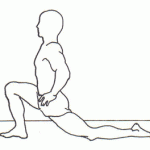The picture above is a simple psoas stretch. I think that the psoas is the most important muscle in the body because it is the main muscle involved in both walking and trauma. Many people believe that the quadriceps, the big muscle of the thigh, walks us through life but to be technical the quad, while aiding in hip flexion, is mainly an extensor of the knee. It is the psoas that catches us from falling (the subject of another blog post)over and over during the course of the day. The psoas is the main muscle of trauma because of its relationship to the sympathetic nervous system. The sympathetic nervous system which dictates our flight or fight response always involves a flexing of the body. To either play dead, flee or fight involves flexion and since the psoas is involved any time we flex it is always part of our flight or fight response. Getting stuck in our flight or fight response, or always remaining in a state of flexion is what I am referring to when I say trauma.
To stretch or not to stretch the psoas is an important question. All muscles need stretching. They need to be active, worked and used; it is the nature of being alive. But, there are times when stretching doesn’t really help. That is when a muscle is filled with stress or tension (trauma); then we need to let go of that muscle. Constructive Rest Position is my favorite way to release the psoas but in this post we will look at a simple psoas stretch. The psoas is a deep core muscle that we shouldn’t necessarily feel when we stretch it. In my mind we never want to feel anything when we stretch. That is an ideal but a decent one worth pursuing. To that end I think I only feel my psoas when I have an issue with it. At which point I back up and do more release work.
In the psoas stretch above, what we call a low lunge, when the front knee moves past the ankle we stretch the back quad. When we then lift the trunk to separate the upper body from the lower body the psoas gets involved. The psoas attaches at the back of the inner thigh so pulling the trunk up and away from the leg will lengthen and extend the psoas. The more you can take the inner thigh back and then tone the core lengthening the spine, the more stretch you will get in the psoas.
When I do a psoas stretch I hope to feel nothing even though there is a good deal of stretching going on. I know that my issues are with the right psoas and I will feel it when it is unhappy. I can stretch the left psoas till the cows come home and there will be no sensation. When I go to the right side, if there is something going on with my psoas, I feel its tightness and tension. There are many days when I don’t feel this and I take that as a sign that things are going well inside.
Getting to know where your psoas is and how it feels or doesn’t feel is a key part of achieving optimal health. Check out this simple psoas stretch to get started.

